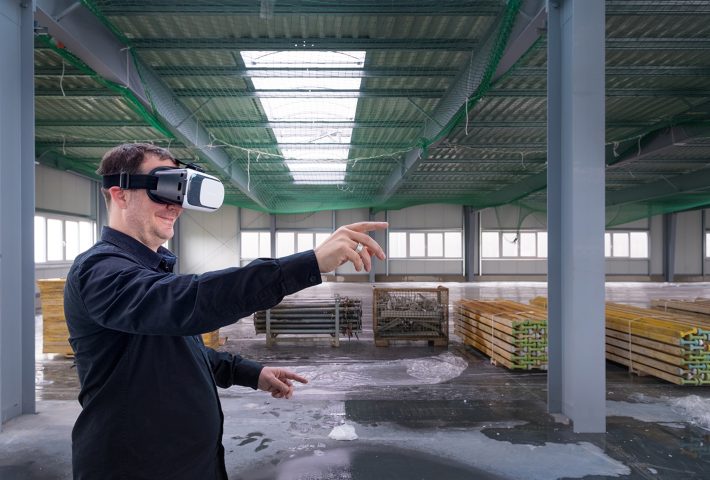Mixed reality: How VR and AR are teaming up to revolutionize construction
September 15, 2022
The use of Virtual and Augmented Reality in architecture design and construction hasn’t always been seamless or feasible, but with the constant evolution of these emerging and disruptive technologies, firms are now extracting huge ROI from mixed reality solutions. So what is mixed reality, and how exactly do firms find value in a technology that has only recently come of age in terms of real-world application? Mixed Reality (MR) is the merging of the real and the virtual, and the construction industry stands to gain more than most from the ability to test and train in simulated environments while providing data-driven insights at each stage of operations.
And even though there are some AECs that have taken the lead on adoption, the construction industry has largely been slow in utilizing emerging technologies. And there are a host of reasons for that, which include a lack of appreciation for the sheer volume of excellent use cases, confusion surrounding application and usability, and a reputation for being used for entertainment purposes. By all rights, Mixed Reality in construction should have already been a long-established tech player in the industry, but with firms now seeing the intrinsic value of and potential for disruption that AR and VR are bringing to their tech stack, the window for early adoption is closing quickly.
The catalog for virtual and augmented reality examples of success is growing across a number of sectors, and their impact on architecture and engineering has been well documented. The similarities of their broader application within construction suggest that there is a lot that the industry can glean from how effectively these technologies have been integrated at every level of decision-making, planning, and execution.
Leading manufacturer NVIDIA recently launched plans to boost engineering and architecture support within the Metaverse, and the platform could yet play a major role in establishing itself as the de facto choice for firms who are willing to push the boat out in order to gain the upper hand on the competition. Construction firms with a forward-thinking strategy that welcome the possibilities of VR and AR as a chance to get ahead will see them gain massive traction in the quest for growth.
The difference between VR and AR in construction
So how does mixed reality work in construction? VR applications in construction have taken the lead on their AR counterpart, and this is particularly true with BIM (Building Information Modelling). With the ability to fully render a 3D environment and make it viewable from every conceivable angle and vantage point, VR construction solutions offer a far greater understanding based on the level of insight provided to every team member involved, from project managers to designers.
This gives firms a 360-degree view of their reporting and planning and allows them the agility to make adaptions swiftly and with the highest degrees of accuracy. Borderless collaboration, remote site inspections, and superior safety training are all facets of what virtual reality can bring to the table and offer innovative solutions to age-old problems. Though its abilities are restricted to the early stages of development, there is no question that it has the potential to save the industry billions of dollars in wasted resources by identifying any concerns before they become costly errors.
So what does augmented reality in construction look like? With AR, the name of the game is projection. Creating virtual elements and adding them to real-world scenes is what AR is all about, and on-site, it has the ability to recreate designs with exceptional accuracy. These line of site improvements allow for greater speed and accuracy when appropriately employed. In essence, augmented reality in construction management provides a deeper, more comprehensive understanding of the dynamics and structure of any given building.
Pivoting to become an exclusively AR building company would be risky. However, with mixed reality, even firms that lack prior experience with AR and VR within the industry can present concepts and plans in 3D and 4D and create virtual tours to dazzle investors.
What does the industry stand to gain from MR implementation?
The ceiling on what can be achieved within the construction industry by using the latest in mixed reality is raised year-on-year. As adoption rates begin to soar, so too will industry-specific innovations. But as it stands, there are more than enough benefits to take construction to previously unseen heights. Let’s take a look at some of the major pros.
- Growing efficiency
As an industry, construction relies heavily on making the most cost-effective decisions without compromising on building quality. There has long been a shortage of high-quality data on which to base these decisions, and mixed reality provides a steady stream of super-accurate data points to ensure designs have adhered to the letter. This is especially important in collaborative projects where the day-to-day activities must be factored in.
- Resource management excellence
One of the most crucial aspects of mixed reality is its ability to save construction firms a ton of money. This cost-efficiency comes from laying out plans in detail and allows firms to walk every step of the project before a single brick has been laid. Firms can remove the jeopardy of costly building errors that go undetected and correct them in a 3D representation. Mixed reality examples of cutting costs also include avoiding reworks, meeting deadlines, and building costs, thanks to its unerring accuracy.
- Better client relations
With mixed reality, clients can live and breathe the process from concept to completion and be able to see prospective plans in ways they had never dreamed possible. This allows totally synergized communication systems by which teams can constantly be updated with changes to project timelines and deadlines. Managers can make decisions in real-time with all the information immediately available to them. This clarity will create long-standing partnerships and lucrative return business.
- Improved on-site safety & training
Safety and security training in construction should always be prioritized, and with mixed reality, employees can gain practical experience in the virtual world. Thousands of hours of hazard and scenario training are available to any staff members at any time and can be used to train new hires or ensure standards are kept over the longer term.
How VR and AR can transform your firm and give you the competitive edge
In Proven Solution, you have a partner capable of harnessing mixed reality’s immense productivity and profitability backed by years of success implementing mixed reality in the construction industry. Take your firm to new levels of efficiency and creativity with our catalog of cutting-edge technologies designed to scale regardless of the size of your operation. Get in touch to see how we can help you establish your organization in the digital age.



